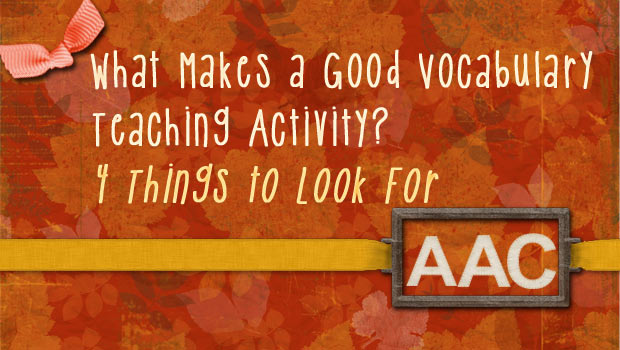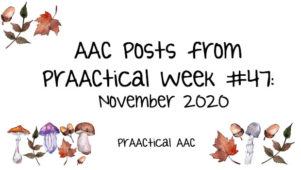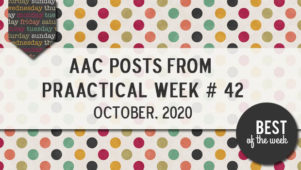What Makes a Good Vocabulary Teaching Activity? 4 Things to Look For

This post is a follow-up to some others in which we introduced a general sequence of how we conceptualize semantic instruction and then went on to discuss the initial step in more detail. Today, we’ll be talking more about Step 2, Teaching the new word(s) with explicit instruction activities. There are so many creative ways to teach new word meanings, but for this step in the process we stick with those that meet a few basic criteria.
Guidelines for Creating or Selecting Activities to Teach New Words
- Rich context: As we’ve said before, context reigns supreme. The cognitive, social, and linguistic cues that children use to learn new word meanings change over time, but at every stage they derive meaning from the surrounding context. Using contextual cues makes us more efficient learners and so it is something we want to encourage in our AAC learners. For a beginning communicator, a rich context is probably some type of hands-on, interactive activity, but for more advanced communicators, the context may come from a story or conversation
- Engaging: We learn through involvement so the more that we can structure the activity for active participation by the AAC users, the more likely they will be to attend and learn. We can enhance retention by creating activities that have the potential for some emotional connection. Activities in which the learner experiences a deep emotion, like joy, curiosity, surprise, or wonder, make it easier for the new word to be stored and retrieved.
- Clarity: We’re always looking for activities that help make the key concept clearer in the mind of the learner. At the earlier stages of word learning, distinctions between what a word means and what it does not mean have to be crystal clear. We can accomplish some of that through verbal explanation and contrast, but we have to follow that up with experiences that allow for the communicator’s active participation.
Here’s an example: Let’s say that we’re teaching the word ‘consume,’ which we’ve defined as ‘to eat, drink, or take in.’ We can help the learner clarify the concept of what it means to ‘consume’ by going through pictures of that show things that can and cannot be consumed. As we look at each one, we can talk about the picture and determine if it is something that can be consumed or not, possibly sorting them into piles as we go. In the beginning we would start with clear-cut examples that fall neatly into one category or the other. Crackers, grass, and gasoline can clearly be consumed by people, cows, and vehicles. Cars and buildings, on the other hand, are not generally thought of as consumables. These are relatively clear positive and negative examples that would be good to start off with. For some learners, the next step would be to look at some more ambiguous exemplars. What about books, for example? Together, we can mull over whether voracious readers consume them as they read. And how about information? Again, we can debate whether or not we consume it at school or on the internet, etc.. It doesn’t much matter whether we determine if these things are or are not consumable (reasoned people can disagree). What matters is this: Learning happens through our conversation and dialogue. The subtleties and nuances of what ‘consume’ really means becomes clearer and clearer. - Interactive: Solitary activities, like worksheets, are fine for practicing things that you’ve already learned, but that’s not therapy. Our focus is on vocabulary teaching experiences that involved dialogue and exchange.
Throughout the month we’ll share ideas for vocabulary teaching activities that meet these criteria but we’d also like to hear from you. What are some of the ways you’ve found to be effective in teaching new words to people who use AAC?
Filed under: PrAACtical Thinking
Tagged With: intervention, language therapy, new words, semantics, vocabulary
This post was written by Carole Zangari




